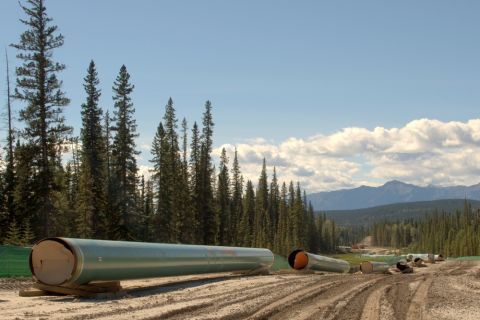Henry Hub natural gas prices are likely to trade between $4 and $6 per million Btu (MMBtu) though 2006. That's because supplies are getting much harder to come by. That makes the natural gas story more investment-worthy than most, says Jefferies & Co. analyst Frank Bracken. In a 206-page report on North American gas trends replete with data and charts, Bracken and his colleagues detail the production situation by state and basin from traditional and non-conventional gas sources, onshore and offshore. The research team scoured federal and state databases, talked to those agencies and polled key operators in many of the important plays and individual fields. Bracken reports that operators need to drill more gas wells, but even if they do, production may continue to decline, supporting high gas prices. What's more, unconventional and deepwater supplies and Canadian imports are having less effect as demand grows. "Even with climbing LNG receipts [412 billion cubic feet of new shipments in 2003 alone], our model sees continued denigration in domestic supplies through gas year 2006-even with the addition of another 100 rigs [drilling for gas]. "In terms of prices, we think 2004 is the riskiest of the next three years," Bracken says. Production is falling for many oft-cited reasons: basin maturation, less wildcat drilling and more expense. But Bracken also points out the majors are not drilling anywhere near the number of conventional gas wells they used to drill in the Lower 48. "They are operating less than 10% of all the conventional gas rigs in the U.S. and this disproportionately augurs for future conventional gas declines." Throughout the 1990s, U.S. gas demand rose to 61 billion cubic feet (Bcf) per day from 52 billion. During that time the U.S. managed to find enough gas by ramping up conventional gas drilling, relying on tight-gas and coalbed-methane gas, and increased Canadian imports. But Bracken argues that the U.S. can no longer muscle additional gas supplies. "Through much of the past four years, U.S. demand has outstripped gas supplies from all sources, resulting in a break-out in prices," Bracken says. "Gas prices averaged over $4.25 per MMBtu during this time." Conventional supplies are declining about 2% per year despite the gas rig count increasing 15% in the past five years. "But it is important to note that the non-conventional supplies, which have been the savior by growing 14% annually over the past 10 years, have essentially peaked, and are actually projected to fall in gas year 2006," Bracken warns. Finally, casinghead gas associated with oil production has declined 4% annually during the past 12 years, no matter the level of oil well drilling. State data In gas year 2003, Lower 48 conventional gas well production fell 2% to an average 39.9 Bcf per day, compared with 45.2 Bcf in first-half 1997. Texas The Lone Star State makes up 28% of Lower 48 supply, producing nearly three times as much gas as the next most-productive state, Wyoming. However, Texas gas output peaked in 1997 during the Austin Chalk drilling boom and has since fallen 1.2 Bcf per day in spite of robust drilling in the Bossier Sand and Barnett Shale plays that have added 1.3 Bcf of new daily production. Gulf Coast onshore production fell from 7.53 Bcf per day in gas year 2001 to below 6.6 billion in 2003, an annualized decline of 6%. Louisiana State authorities estimate output was 3.7 Bcf per day in gas year 2003, down 3.8% from 2002. Bracken thinks increased drilling in northern Louisiana's tight-gas plays will partially offset declines in the southern part of the state and in state waters. Oklahoma Gas production is forecast to be flat for the next three years, averaging about 4.2 Bcf per day this year. Gains in the Anadarko Basin and in coalbed-methane drilling will help offset long-term declines in traditional areas. Statewide daily production has fallen 1.6 Bcf since gas year 1991. Wyoming Beefed-up pipeline capacity enabled operators to double conventional production to 3.6 Bcf per day from between gas years 1991 and 2001. Aside from the rapidly growing Jonah/Pinedale and Madden areas, however, conventional output is now declining. Wyoming produced nearly 4.95 Bcf daily in gas year 2003. That is forecast to go up to 5.4 Bcf per day by 2006. Colorado Another bright spot, it produced 2.8 Bcf a day in gas year 2003-more than triple the output of 1991. Coalbed-methane gas is roughly half the state's output and is poised to wane. Several tight-gas sand plays will make up the slack. Gulf of Mexico The mix of gas sources has changed markedly here. Since gas year 1997, some 3.1 Bcf per day of gains in deepwater output have offset a decline of 5.1 Bcf per day on the Shelf. Today operators produce 4.1 Bcf a day from the deepwater Gulf and about 8.1 billion from the Shelf. In 2003, nine deepwater fields began producing. But, the 49 deepwater fields placed onstream before 2002 have shown an annualized decline rate of 22%. Coalbed methane Once a source of steady production growth, the San Juan Basin in New Mexico has matured. The New Mexico side peaked in 1999 at 1.67 Bcf per day and has since fallen to 1.28 Bcf as of year-end 2002. Bracken says the decline rate has settled at about 10% annually. Looking at all the U.S. basins that produce coalbed methane today, including emerging areas such as the Forest City Basin, the rate of coalbed-methane production growth is slowing markedly, even though the aggregate amount is increasing. In gas year 1994, U.S. coalbed-methane production grew 18.8%; in 1998, 8.5%; and in 2003, 4.3%. -Leslie Haines
Recommended Reading
Imperial Expects TMX to Tighten Differentials, Raise Heavy Crude Prices
2024-02-06 - Imperial Oil expects the completion of the Trans Mountain Pipeline expansion to tighten WCS and WTI light and heavy oil differentials and boost its access to more lucrative markets in 2024.
US Gulf Coast Heavy Crude Oil Prices Firm as Supplies Tighten
2024-04-10 - Pushing up heavy crude prices are falling oil exports from Mexico, the potential for resumption of sanctions on Venezuelan crude, the imminent startup of a Canadian pipeline and continued output cuts by OPEC+.
Oil Broadly Steady After Surprise US Crude Stock Drop
2024-03-21 - Stockpiles unexpectedly declined by 2 MMbbl to 445 MMbbl in the week ended March 15, as exports rose and refiners continued to increase activity.
Exxon’s Payara Hits 220,000 bbl/d Ceiling in Just Three Months
2024-02-05 - ExxonMobil Corp.’s third development offshore Guyana in the Stabroek Block — the Payara project— reached its nameplate production capacity of 220,000 bbl/d in January 2024, less than three months after commencing production and ahead of schedule.
Russia Orders Companies to Cut Oil Output to Meet OPEC+ Target
2024-03-25 - Russia plans to gradually ease the export cuts and focus on only reducing output.


